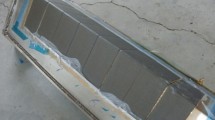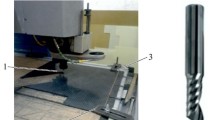During the curing process of thermoset composites, residual stresses inevitably develop in them and lead to their curing deformation after the manufacturing process. This work was aimed at investigating the effect of tool–part interaction and bending stiffness on the curing deformation of L-shaped composite structures. Therefore, a twostep calculation model was developed. It consists of a numerical model to capture the residual stress due to the tool–part interaction and a viscoelastic model considering the anisotropic material properties. Calculation results were compared with experimental data, and a good agreement was found to exist between them.












Similar content being viewed by others
References
L. Na, et al, “A new process control method for microwave curing of carbon-fibre-reinforced composites in aerospace applications,” Composites: Pt. B, 122, 61-70 (2017).
J. M. Svanberg and J. A. Holmberg, “An experimental investigation on mechanisms for manufacturing induced shape distortions in homogeneous and balanced laminates,” Composites: Pt. A, 32, 827-838 (2001).
K. Cinar et al., “Effect of residual stress on the bending response of L-shaped composite laminates,” Compos. Struct., 246, 112425 (2020).
E. Zappino et al., “Analysis of process-induced deformations and residual stresses in curved composite parts considering transverse shear stress and thickness stretching,” Compos. Struct, 241, 112057 (2020).
C. Bellini and L. Sorrentino, “Analysis of cure induced deformation of CFRP U-shaped laminates,” Compos. Struct, 197, 1-9 (2018).
D. W. Radford and T. S. Rennick, “Separating sources of manufacturing distortion in laminated composites,” J. of Reinforced Plastics and Composites, 19, 621-641 (2000).
P. Causse, E. Ruiz and T. François, “Spring-in behavior of curved composites manufactured by flexible injection,” Composites: Pt. A, 43, 1901-1913 (2012).
C. Albert and G. Fernlund, “Spring-in and warpage of angled composite laminates,” Compos. Sci. Technol., 62, 1895-1912 (2002).
C. Bellini, et al, “Spring-in analysis of CFRP thin laminates: numerical and experimental data,” Compos Struct, 193,17-24 (2017).
Z. Yuan et al., “An analytical model on across-the-thickness stresses and warpage of composite laminates due to tool–part interaction,”Composites: Pt. B, 91, 408-413 (2016).
A. R. A. Arafath, R. Vaziri, and A. Poursartip, “Closed-form solution for process-induced stresses and deformation of a composite part cured on a solid tool: Part I -Flat geometries,” Composites: Pt. A, 39, 1106-1117 (2008).
G. Twigg, A. Poursartip, and G. Fernlund, “Tool–part interaction in composites processing. Part I: experimental investigation and analytical model,” Composites: Pt. A, 35, 121-133 (2004).
D. W. Radford, “Balancing mechanisms of distortion to yield distortion-free/shape stable composites,” J. of Reinforced Plastics and Composites, 29,1875-1892 (2010).
M. R. Wisnom, K. D. Potter, and N. Ersoy, “Shear-lag analysis of the effect of thickness on spring-in of curved composites,” J. Compos. Mater., 41, 1311-1324 (2006).
A. R. A. Arafath, R. Vaziri, and A. Poursartip, “Closed-form solution for process-induced stresses and deformation of a composite part cured on a solid tool: Part II - Curved geometries,” Composites: Pt. A, 40, 1545-1557 (2009).
K. Takagaki, S. Minakuchi, and N. Takeda, “Process-induced strain and distortion in curved composites. Part I: Development of fiber-optic strain monitoring technique and analytical methods,” Composites: Pt. A, 103, 236-251 (2017).
K. Takagaki, S. Minakuchi, and N. Takeda, “Process-induced strain and distortion in curved composites. Part II: Parametric study and application,” Composites: Pt. A, 103, 219-229 (2017).
A. Ding et al.,“ A new analytical solution for cure-induced spring-in of L-shaped composite parts,” Compos. Sci. Technol., 171, 1-12 (2019).
C. Liu and Y. Shi, “A thermoviscoelastic analytical model for residual stresses and spring-in angles of multilayered thin-walled curved composite parts,”Thin-Walled Structures, 152, 106758 (2020).
G. C. Pereira et al., “Spring-back behavior on L-shaped composite structures: A statistical analysis of angular recovery as a function of time and residual cure,” Composites: Pt. A, 124, 105491 (2019).
R. D. Oliveira, et al, “Experimental investigation of the effect of the mould thermal expansion on the development of internal stresses during carbon fibre composite processing,” Composites: Pt. A, 39, 1083-1090 (2008).
K. Cinar et al., “Modelling manufacturing deformations in corner sections made of composite materials,” J. Compos. Mater., 48, 799-813 (2014).
X. Zeng and J. Raghavan, “Role of tool–part interaction in process-induced warpage of autoclave-manufactured composite structures,” Composites: Pt. A, 41, 1174-1183 (2010).
L. Che et al., “Investigation of curing deformation behavior of curved fiber metal laminates,” Compos Struct, 232,111570 (2020).
L. Mezeix et al., “Spring-back simulation of unidirectional carbon/epoxy flat laminate composite manufactured through autoclave process,” Compos. Struct., 124,196-205 (2015).
G. Twigg, A. Poursartip, and G. Fernlund, “Tool–part interaction in composites processing. Part II: numerical modelling,” Composites: Pt. A, 35, 135-141 (2004).
N. Ersoy et al., “An experimental method to study the frictional processes during composites manufacturing,” Composites: Pt. A, 36, 1536-1544 (2005).
Y. Zhen et al., “Evolution of curing residual stresses in composite using multi-scale method,” Composites, Pt. B, 155, 49-61 (2018).
S. R. White and Y. K. Kim, “Process-induced residual stress analysis of AS4/3501-6 composite material,” Mech. Compos. Mater., 5, 153-186 (1998).
Y. K. Kim and S.R. White, “Stress relaxation behavior of 3501-6 epoxy resin during cure,” Polym. Eng. Sci., 36, 2852-2862 (1996).
L. Xing et al., “A new stress-based multi-scale failure criterion of composites and its validation in open hole tension tests,” Chinese J. Aeronaut, 27, 1430-1441 (2014).
R. Joven et al., “Characterization of shear stress at the tool–part interface during autoclave processing of prepreg composites,”J APPL POLYM SCI, 129, 2017-2028 (2013).
E. Kappel, “A zone-based approach to predict process-induced distortions of composite structures based on a ‘spring-in reference curve,” Compos. Struct, 209, 143-149 (2019).
Acknowledgements
The authors would like to acknowledge the financial supports by the National Nature Science Foundation of China (51575442, 51805430, 51805429) and the Shaanxi Natural Science Foundation (2019JQ-183).
Author information
Authors and Affiliations
Corresponding author
Additional information
Russian translation published in Mekhanika Kompozitnykh Materialov, Vol. 56, No. 6, pp. 1141-1162, November-December, 2020.
Rights and permissions
About this article
Cite this article
Yuan, Z., Yang, G., Yang, Z. et al. Process-Induced Deformation of L-Shaped Laminates: Analysis of Tool–Part Interaction. Mech Compos Mater 56, 789–804 (2021). https://doi.org/10.1007/s11029-021-09924-7
Received:
Revised:
Published:
Issue Date:
DOI: https://doi.org/10.1007/s11029-021-09924-7




